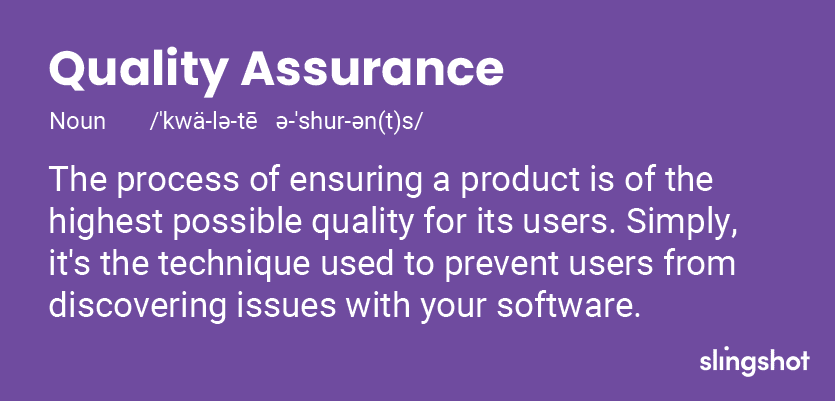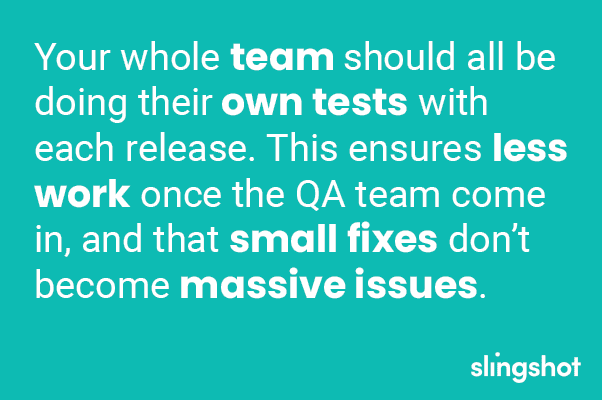Have you ever had the nightmare where you’re in class and just realized the final presentation is tomorrow? Scary, we know!
Imagine if right then you had a choice: prepare your speech, or just wait and see what happens. As you can imagine, you’re more likely to walk out of there feeling good if you put in the effort up front instead of just winging it.
Now how does this relate to development? When building software, you can either deploy it and hope for the best, or do some QA testing to ensure you’re good.
Have you ever had the nightmare where you’re in class and just realized the final presentation is tomorrow? Scary, we know!
Imagine if right then you had a choice: prepare your speech, or just wait and see what happens. As you can imagine, you’re more likely to walk out of there feeling good if you put in the effort up front instead of just winging it.
Now how does this relate to development? When building software, you can either deploy it and hope for the best, or do some QA testing to ensure you’re good.
What is QA testing, and is it right for you? Stick around and read about the process of QA Testing, and why it’s important to do.
Summary
- QA, or Quality Assurance, Testing is an intensive software testing process that takes a deep-dive on all aspects of your tech.
- The process includes building realistic requirements, finalizing your strategy, building then executing the tests, and continuously testing with each new release.
- QA is important because it helps save time and money in the long run, stops small mistakes from making major impacts, helps alleviate scope creep, makes sure you’re not losing your user’s trust, and ensures data security.
What’s involved in QA Testing?
To start out, we need to mention the acronym. QA stands for quality assurance. When you’re doing QA testing, you’re making sure that everything you’ve designed and developed is of the highest possible quality. This goes beyond just looking for bugs; it’s a comprehensive and systematic testing of specifications, development, techniques, tools, and processes.

With that in mind, it’s important to try and get QA involved as early as possible. A QA manager or QA lead needs to be there from the beginning to make sure that the system being brought to life can meet the standards you’re setting for it.
Now onto how it’s done!
1 – Define What’s Happening
We just said it, but getting QA started ASAP is going to save you in the long run. Wouldn’t you rather catch an issue before it happens as opposed to at the very end of development? If possible, you should have your QA team (or at least a member) on a project from the jump. Another reason to involve QA early is so that they can gain knowledge regarding the solution being built. This knowledge helps them craft a better testing strategy.
But what can a QA Manager do before there’s anything to test? A lot, actually. They can help you nail down functional and non-functional requirements. This way, you have someone on your side whose main goal is to ensure requirements are consistent, trackable, and thorough.
2 – High Level Strategy
Now that you know what’s going to be built, your QA team can start thinking about how they’re going to test it. In the beginning, there won’t be any development to test just yet. At this stage, the strategy is more high-level: what do we plan to do, what’s the project’s budget, and what are the current deadlines?
Engaging QA early provides the time necessary to develop a sound testing strategy for the planned solution. For example, should the solution require ADA compliance, contain a complex API, need to work on various devices… these would all significantly impact the overall testing strategy. Perhaps specialized testing tools or skillsets will be required.
As the product moves closer to completion, aspects of your QA plan will get more defined. In the end, your Test Plan should include: a full strategy, the scope of what to test, constraints to keep in mind, methods of how you’ll test, the level of testing required, how you’ll track bugs, and what each QA team member is responsible for.
3 – Craft the Tests
Once you have a strategy in place, you need to figure out how you’ll implement it. The QA team will now start drafting test cases: step-by-step instructions on what is going to be tested. They’ll later evaluate the test cases against the developed product to validate the functionality and design.
Now is also the time when your team will need to prepare the testing environment; these tests have to happen somewhere! Your testing environment will be as close to a copy-paste of the production environment as possible. The testing environment will give your QA team a place to check on builds, designs, and updates.
4 – Execute the Tests
We’ve got the playbook, now let’s put it to use. But wait – don’t send in the QA calvary just yet. Product managers, designers, and developers should all be doing their own tests with each release. As an example, developers should write unit tests to validate written code. These can be executed automatically via a continuous integration process, reducing the likelihood of bugs later. This ensures there isn’t a mountain of work for the QA team, and that small fixes don’t become massive ones.

Now it’s time! Your QA team will now officially begin testing the build, whether that’s manually with the test cases, or automatically through an automation engine. Any bugs that pop up here should be noted and tracked to make sure they get fixed. The bug report describes the expected result, actual result, and steps to reproduce.
5 – Rinse, Repeat
So you just sent in the exterminator, and the bugs are supposed to be gone. Don’t take their word for it; test again. You want to make sure you didn’t miss anything in that original test, or that the fixes didn’t cause new bugs.
A fix in one area of the app may have unintended consequences in another, so a regression test prior to release is a great idea. What’s a regression test? Good question: it’s a series of tests that validate either a specific section of the app or the app as a whole to double-check it functions as expected. A regression test plan can be as simple as having a spreadsheet with your test cases and the pass/fail status of them.
This step in the process isn’t the only time when you get bugs fixed: you should continuously test after the app is launched. Any new releases or updates should be QA tested to ensure that they meet the quality standards of the rest of the app.
Why is QA Testing Important?
Save resources long-term
Of course doing above-and-beyond testing is going to be more expensive. But there’s a reason it’s looked at as an investment: spend now to save later. It’s going to take a lot less time and effort to fix an issue early on, as opposed to after the build is complete. Save yourself the heartache of a bloated budget for fixes and plan ahead for QA.
The Butterfly Effect
For those that don’t know, the butterfly effect is a theory that even small changes can lead to drastically different outcomes. The name comes from the metaphorical pose by Edward Lorenz: can a butterfly flapping its wings lead to a tornado weeks later?
While not the same type of bug, we can learn from the butterfly effect when it comes to development: a small tweak can lead to a complete breakdown of the build, if there isn’t any QA to test it. If you’re not testing every component, no matter its size, how do you know it’s going to work as expected?
Stop the Scope Creep
Someone reading that header just got a shiver down their spine. Scope creep can cause a great MVP to turn into a bloated feature-filled mess. Adding a feature or two is fine from time to time, but you want to make sure it’s helping the app as opposed to hurting it.
A QA team member can help elevate this issue by bringing their side of the story to the table. They’ll be looking at the project from a tester’s perspective: will this cause a security loophole? Does this feature put the project’s scalability at risk? Having someone there to pump the breaks can keep your scope manageable.
Don’t lose trust
If you’re an established company, you know how hard it was to grow your brand and keep customers happy (both external and internal). Getting users to adopt anything new can be tricky, especially if it’s tech. So you can bet it’s nearly impossible to get users to buy-in to a new product that’s glitching or hard to use. It’s smart to invest in testing upfront, so that your product doesn’t die via 1-star reviews and get trashed.

Keep Data Secure
Now is the time to talk about legal issues: security breaches and data leaks are a real issue. With Europe’s GDPR and California’s CCPA, your user’s information needs to be more secure than ever.
But how can you make sure your product is secure? Testing, of course! Your QA team can check for vulnerabilities in your code, preventing the possibilities of hacks and eliminating the risks of a breach.
Conclusion
QA Testing is an all-encompassing analysis of your tech to ensure it meets the highest quality standards. It’s important to undergo QA testing, so that you can protect your resources, scope, reputation, and information.
Hopefully this calmed you, much like a nightlight can calm you after a nightmare. Fingers crossed your next dream isn’t about you realizing you haven’t attended a class all semester that you didn’t know you had…
Sweet dreams! ?




